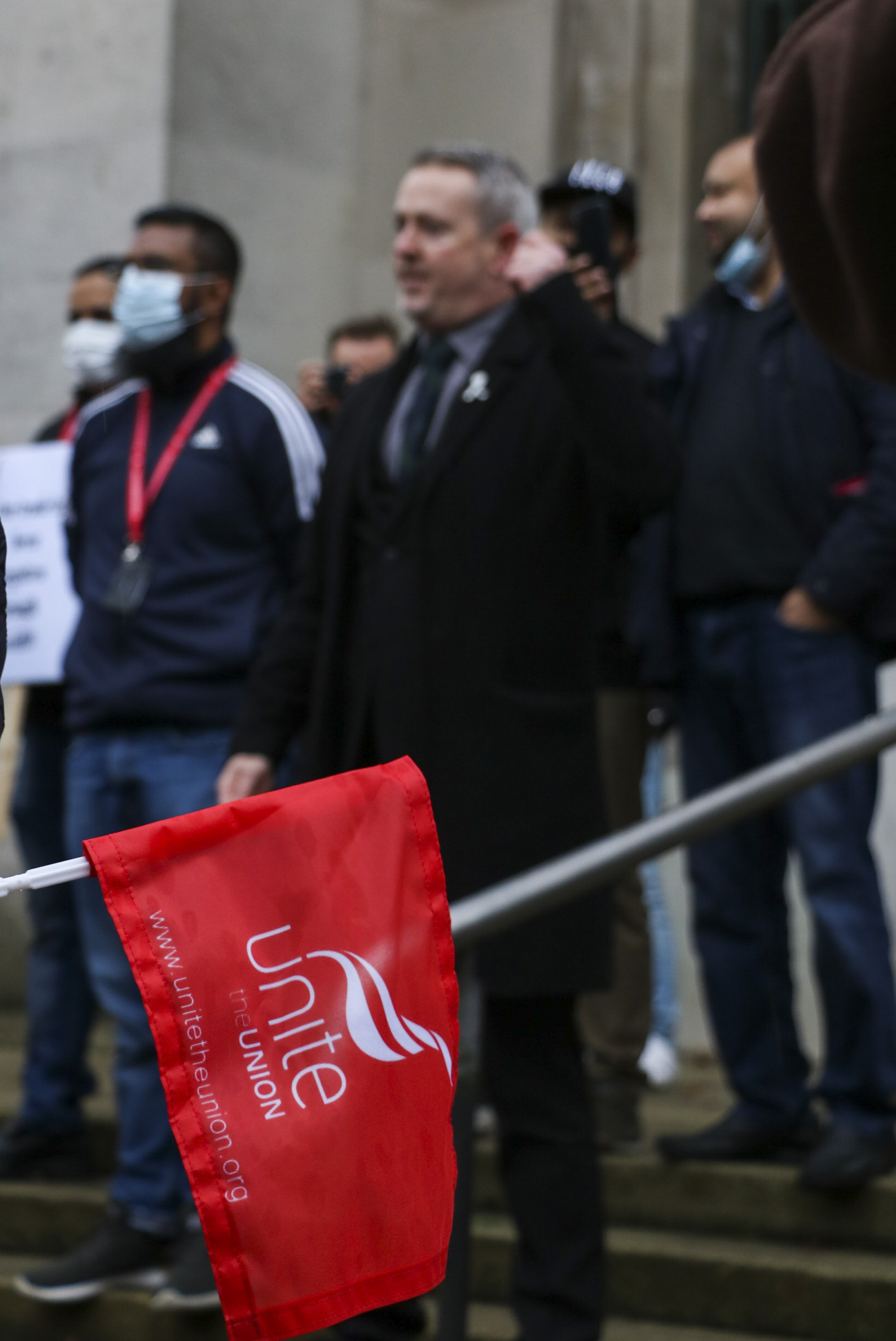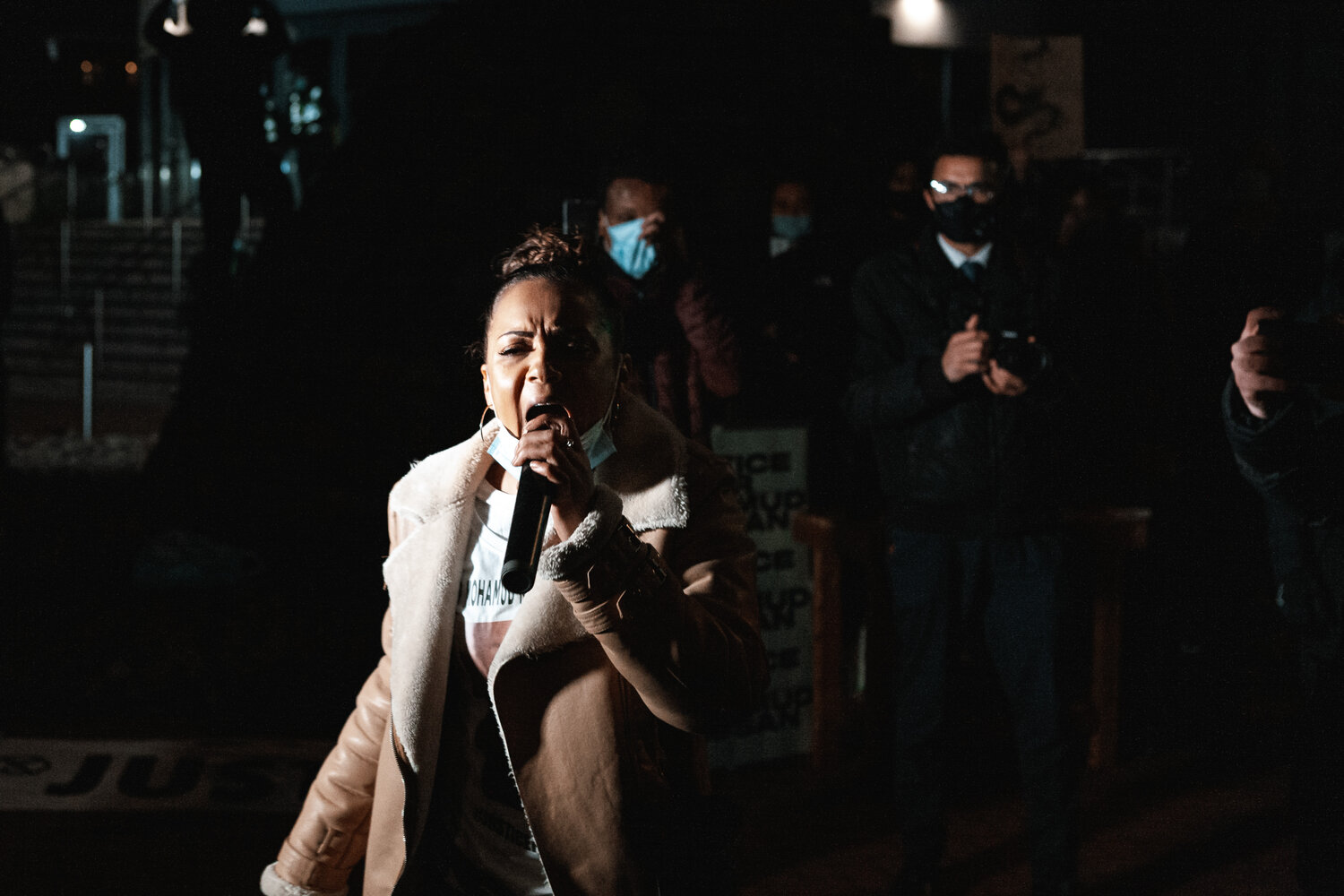
Workers Have Seen How Essential They Are – Now They’re Fighting Back | Steve Davies
Working people are facing challenges from all sides but for the first time in years, they have real leverage and therefore an opportunity to push back and make serious gains.
Image: Taxi drivers in the Unite union protest for emergency Covid support, Autumn 2020, by Tom Davies
The pandemic has forced many changes on our lives but one area where the changes may outlast COVID 19 is the world of work. In response to the virus, many of us have changed where we work, how we work, when we work; for some it’s meant furlough, unemployment or a change of job because of business failure.
On the other hand, those designated as ‘essential workers’ have worked through the pandemic, often risking their lives to provide a service. Many people have a new appreciation of who is or who isn’t an ‘essential worker’ – would anyone now argue that a hedge fund manager was ‘essential’ compared with a nurse, HGV driver, a postie or a worker in a care home or supermarket? Many of us have also learned how low sick pay is in the UK (£96.35 per week, one of the lowest rates in Europe).
Brexit has also had an impact on growing labour shortages in sectors which have been heavily reliant on EU workers, such as transport, care homes, hospitality, agriculture and others.
It’s worth noting, however, that not all of these issues are mainly about Brexit. With HGV drivers, for example, the long effects of neoliberalism – driving down terms and conditions, low pay, poor facilities and high cost of entry – have played a bigger role in the shortage.
In addition, at a time when inflation is going up and pay rises low or non-existent, the UK government has decided to make workers pay for the cost of economic recovery by raising National Insurance Contributions (a tax which disproportionately affects low paid workers and leaves untouched those who make their income from rents, dividends or profits).
The UK Government is also cutting Universal Credit (40% of the recipients of which are low paid workers) by £20 a week and planning big cuts in public services. Finally, the pre-COVID housing crisis is likely to get worse, particularly for those renting, as both the Welsh and UK governments have lifted the ban on ‘no-fault’ evictions.
This all adds up to pretty grim news for millions of people, but there is the beginning of a fight back. Workers are joining trade unions in greater numbers than for many years, and acting through strikes, demonstrations, lobbying and bargaining to defend jobs, win pay rises, ensure work is safe and push back against the imposition of insecure work. In short, unions are back.
Despite 40 years of anti-union legislation, hostility from Conservative governments and indifference from New Labour governments, in 2020 union membership grew for the fourth consecutive year to a total of 6.56 million people. The proportion of UK employees who are trade union members (union density) is now just under a quarter at 23.7%.
The last time four consecutive annual union membership rises occurred was in the 1970s. This is not quite a return to those days (in 1979 union membership hit a high point of 13.2 million with over half of all employees union members) but it is still very significant and confirms the trade union movement as the largest social movement in the UK.
And in a crisis situation sometimes there are opportunities as well as challenges. The pandemic itself showed the importance of unions. Without union pressure on the government, there would have been no furlough scheme which was a life raft for many workers, despite its limitations. It was the unions who led the push on safety at work in relation to COVID, particularly for health workers – fighting for decent PPE and work adjustments.
This is not just in the NHS or care homes: PCS the civil service union led strikes at Swansea’s DVLA to force management to make their workplace safe (after an outbreak of COVID involved 700 cases and one death). In Cardiff, Unite boosted its membership among taxi drivers as they joined together to successfully pressurise the Welsh Government to extend hardship funding to the drivers.
Some employers used the pandemic as an excuse to try to introduce so-called ‘fire and rehire’. This is where an employer lays off staff and then offers to take them back on far inferior contracts (with cuts in pay and worse conditions). In workplaces without unions, fire and rehire was rammed through. Elsewhere it was different. Some gung-ho employers, like British Gas, were forced to compromise, while in other cases like Go North West Buses, drivers’ fought back through their union Unite and, after lengthy strike action, the company agreed never to use fire and rehire.
The areas with the highest levels of labour shortages at the moment are where pay is traditionally low, job security non-existent (with zero hours contracts) and conditions are poor. The Office of National Statistics reported in September that ‘vacancies rose to a record 1,034,000 in June to August 2021’ – employers are desperate for staff.
Yet, according to the Joseph Rowntree Foundation ‘more than half (56%) of people in poverty are now in a working family’ and their pay is often so low that they are entitled to Universal Credit.
British employers have relied on cheap labour for so long that now they are in trouble and workers and their unions argue that it’s time for them to pay up. And the employers are beginning to recognise this, for example, Tesco is offering HGV recruits a £1000 signing on bonus. Unite – the Tesco drivers’ union – points out that this is just a temporary fix, and are pushing for a permanent better deal for drivers.
Labour shortages represent an opportunity for workers to push wages up and improve conditions. The best way to do that is for workers to get organised by joining a union and pushing for industrial action. Many are doing so.
A number of small dynamic new unions like the Independent Workers of Great Britain (IWGB) and the United Voices of the World (UVW) focus on precarious workers who are often young, migrants and people of colour. They organise a huge range of people previously regarded by the traditional unions as difficult to reach, from care workers to couriers, baristas to security guards and many more. In a new and encouraging move, one of the newer unions (UVW) is working closely with a more established union (PCS) in the Royal Parks in London. As a result, outsourced cleaners and attendants have taken joint strike action over pay and conditions.
Disputes related directly to the pandemic have also seen unions report big increases in membership, as workers band together for safety, security and to improve their lives at work. The teachers’ union, NEU, reported 50,000 new members in the first six months of the pandemic (6,000 joined in one weekend) and went on to organise probably the largest union meeting in history with 400,000 on a Zoom call in January this year. UNISON, the GMB and Unite all also reported tens of thousands of new members.
After spending the first few months of the pandemic urging the public to stand on their doorsteps and clap essential workers, ministers are now trying to impose a pay freeze on large parts of the public sector and a below inflation pay rise on NHS staff. After the sacrifices of the last 19 months (including the deaths of over 1500 care and health staff as a result of COVID) essential workers feel that they’re entitled to more than a pay cut.
Health and care workers are exhausted but angry. And they have popular support with opinion polls consistently showing that the public thinks they are not paid enough and should get more than the 3% pay offered. All of the main health unions now have the opportunity to move towards strike action, after consultative ballots showed members’ anger over the pay offer. Even in Wales, with a government that sees itself as more sympathetic to health unions, workers’ response was to angrily reject the pay offer.
With labour shortages in other key areas in the private sector (which may last up to two years), that amounts to a large group of workers with the motivation and in some cases the obvious leverage to win improvements in pay and working conditions. With the added ingredient of increased membership and stronger organisation at the workplace, this is a potentially powerful cocktail.
And strong organisation at the workplace is now a big focus for many unions. In the last year or two, thousands of shop stewards and local union representatives from all over the country have been involved in training to build worker confidence and union capacity through training methods and skills led by the American union organiser Jane McAlevey. Unions like the teachers (NEU), nurses (Royal College of Nursing), university staff (UCU) and civil servants (PCS) have been prominent in this.
Sharon Graham, the new leader of Britain and Ireland’s most important union Unite, has also highlighted the importance of the workplace for her union. So much so, that she’s not attending next week’s Labour conference because she intends to be standing with her members in dispute with employers: ‘I’m focusing as a priority on Jobs, Pay and Conditions by standing on picket lines with members rather than sitting at a conference’. She has already warned ‘bad bosses’ to take note of her election and told Amazon to improve the way it treats its staff and allow them to join unions or ‘reckon with us’. The union is confident that this will be an attractive message for workers fighting for better pay and conditions all over the country.
Working people are facing challenges from all sides but for the first time in years, they have some leverage and therefore opportunities to push back and make serious gains. For workers, whether public or private sector, permanent or zero hours, full time or part time,, there has never been a better time to join a union and fight back.
Steve Davies is a writer and researcher on work and trade unions.
Upon request, the fee for this article has been given to ACORN Cardiff.


